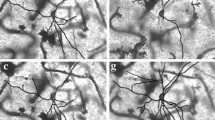Abstract
The dog caudate nucleus was studied by the Nissl, Kluver-Barrera, and Golgi methods in the usual planes of section. A complex spatial organization of the caudate nucleus was established. Radial bundles of fibers form fibrous layers through which run blood vessels and in which large neurons (long-axon reticular and large short-axon smooth-dendritic) and also two types of small cells are located. In the mesh of the fibrous layers barrel-shaped concentrations of small (17.5 µm, about 2–4%, small short-axon smooth-dendritic) and medium-sized (25 µm, about 96–98%, long-axon densely branching spinous) cells can be observed. These concentrations have the appearance of two or three layers of elongated "barrels," their axis perpendicular to the surface of the internal capsule. The stria periventricularis of the caudate nucleus and certain others of its regions are less differentiated.
Similar content being viewed by others
Literature cited
É. B. Arushanyan and V. A. Otellin, The Caudate Nucleus [in Russian], Nauka, Leningrad (1976).
V. P. Babmindra and F. Wallberg, "Sources of afferent pathways of the cat motor cortex detected by the peroxidase method," Arkh. Anat. Gistol. Émbriol.,74, No. 5, 13 (1978).
T. A. Leontovich, "The fine structure of the basal ganglia," Zh. Nevropatol. Psikhiat., No. 2, 168 (1954).
T. A. Leontovich, "Neuronal structure of the basal ganglia in some mammals and man," in Development of the Central Nervous System [in Russian], Medgiz, Moscow (1959), pp. 185–204.
T. A. Leontovich, "Principles of qualitative-quantitative organization of neurons of the subcortical and oldest cortical formations of the carnivore forebrain," Dissertation for the Degree of Doctor of Medical Science (1972).
T. A. Leontovich, Neuronal Organization of Subcortical Formations of the Forebrain [in Russian], Meditsina, Moscow (1978).
N. N. Oleshko, V. A. Maiskii, V. A. Cherkes, and V. K. Berezovskii, "Investigation of the neuronal organization of the cat's caudate nucleus by the retrograde axonal horseradish transport method," Dokl. Akad. Nauk SSSR,249, No. 5, 1258 (1979).
N. V. Suvorov, The Striatal System and Behavior [in Russian], Nauka, Leningrad (1980).
V. A. Cherkes, Outlines of the Physiology of the Basal Ganglia of the Brain [in Russian] Izd. Akad. Nauk Ukr. SSR, Kiev (1963).
R. Chronister, K. Farnell, and L. Marko, "The rodent neostriatum," Brain Res.,108, No. 1, 37 (1976).
J. A. Cospito, M. S. Levine, and A. M. Adinolfi, "Organization of developing precruciate corticostriate projections in kittens," Exp. Neurol.,67, No. 2, 447 (1980).
P. S. Goldman and W. J. Nauta, "An intricately patterned prefronto-caudate projection in the rhesus monkey," J. Comp. Neurol.,171, No. 3, 369 (1977).
A. M. Graybiel and C. W. Ragsdale, "Histochemically distinct compartments in the striatum of human, monkey, and cat demonstrated by acetyl thiocholinesterase staining," Proc. Natl. Acad. Sci. USA,75, No. 11, 5723 (1978).
A. M. Graybiel and C. W. Ragsdale, "Clumping of acetylcholinesterase activity in the developing striatum of the human fetus and young infant," Proc. Natl. Acad. Sci. USA,77, No. 2, 1214 (1980).
A. M. Graybiel, C. W. Ragsdale, and S. Moon, "Compartments in the striatum of the cat observed by retrograde cell labeling," Exp. Brain Res.,34, No. 1, 189 (1979).
I. Grofova, "The identification of striatal and pallidal neurons projecting to substantia nigra," Brain Res.,91, No. 2, 286 (1975).
I. Grofova, "Types of striatonigral neurons labeled by retrograde transport of horseradish peroxidase," Appl. Neurophysiol.,42, No. 1, 25 (1979).
A. Jayaraman, "Anatomical evidence for cortical projections from the striatum in the cat," Brain Res.,195, No. 1, 29 (1980).
J. Kemp and T. Powell, "The structure of the caudate nucleus of the cat," Phil. Trans. R. Soc. Ser. B.,262, No. 2, 384 (1971).
G. Krauthamer and D. Albe-Fessar, "Inhibition of nonspecific sensory activities following striopallidal and capsular stimulation," J. Neurophysiol.,28, No. 1, 100 (1965).
H. Kunzle and K. Akert, "Efferent connections of cortical area 8 inMacaca fascicularis," J. Comp. Neurol.,173, No. 1, 147 (1977).
T. A. Leontovich, "Quantitative analysis and classification of subcortical forebrain neurons," in: Golgi Centennial Symposium, Raven Press, New York (1975), pp. 101–122.
P. L. Mensah, "The internal organization of the mouse caudate nucleus," Brain Res.,137, No. 1, 53 (1977).
L. Olson, L. O. Boreus, and A. Seiger, "Histochemical demonstration and mapping of 5-HT and catecholamine-containing neuron systems in the human fetal brain," Anat. Entwickl. Gesch.,139, No. 2, 259 (1973).
P. Petrovicky, "Ascending pathways from the substantia nigra to the striatum," Folia Morphol.,20, No. 2, 156 (1972).
G. J. Royce, "Autoradiographic evidence for a discontinuous projection to the caudate nucleus from the centromedian nucleus in the cat," Brain Res.,146, No. 1, 145 (1978).
M. E. Scheibel and A. B. Scheibel, "Dendrite bundles as sites for central programs: an hypothesis," Int. J. Neurosci.,6, No. 2, 195 (1973).
D. Tanaka, T. Gorska, and K. Dutkiewicz, "Differential projections to the neostriatum from the areas of the primary and supplementary motor cortices in the dog," Brain Res.,172, No. 1, 150 (1979).
K. G. Usunoff, R. Hassler, K. Romansky, et al., "The nigrostriatal projection in the cat," J. Neurol. Sci.,28, No. 2, 265 (1976).
A. K. Wright and G. W. Arbuthnott, "The pattern of innervation of the corpus striatum by the substantia nigra," Neuroscience,6, No. 10, 2063 (1981).
Additional information
Brain Institute, Academy of Medical Sciences of the USSR, Moscow. Translated from Neirofiziologiya, Vol. 15, No. 5, pp. 474–484, September–October, 1983.
Rights and permissions
About this article
Cite this article
Leontovich, T.A. Spatial organization of the caudate nucleus in dogs. Neurophysiology 15, 340–348 (1983). https://doi.org/10.1007/BF01066750
Received:
Issue Date:
DOI: https://doi.org/10.1007/BF01066750



